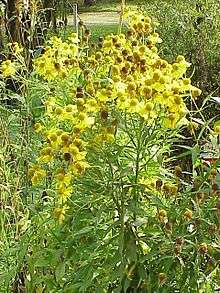Helenium autumnale
Helenium autumnale is a North American species of flowering plants in the sunflower family. Common names include common sneezeweed and large-flowered sneezeweed.[2][3][4]
| Helenium autumnale | |
|---|---|
 | |
| Scientific classification | |
| Kingdom: | |
| (unranked): | |
| (unranked): | |
| (unranked): | |
| Order: | |
| Family: | |
| Tribe: | |
| Genus: | |
| Species: | H. autumnale |
| Binomial name | |
| Helenium autumnale L. 1753 | |
| Synonyms[1] | |
| |
Description
Common sneezeweed is a perennial herb up to 130 cm (51 1⁄3 in; 4 1⁄3 ft) tall. In late summer and fall, one plant can produce as many as 100 yellow flower heads in a branching array. Each head has 11–21 ray florets surrounding sometimes as many as 800 disc florets.[5]
Distribution and habitat
This plant is widespread across much of the United States and Canada, from Northwest Territories as far south as far northern California, Arizona, Louisiana, and Florida. It has not been found in southern or central California, New Hampshire, or the 4 Atlantic Provinces of Canada.[6][7][8][9]
Cultivation
Common sneezeweed is cultivated as a garden perennial. There are multiple named varieties varying in color and height. 'Pumilum Magnificum' is a yellow variety about two feet tall. 'Bruno', a reddish-brown cultivar, 'Kupfersprudel', which is yellow/orange, and 'Butterpat', which is golden, all grow 3 to 3.5 feet (91 to 107 centimetres) tall. 'Chippersfield Orange' is up to 0.91 metres (3 ft) tall and is orange streaked with gold.[10]
Uses
The plant owes its name to the use of its dried leaves in snuff, the inhaling of which causes sneezing—supposedly casting out evil spirits.[11]
References
- "Helenium autumnale". The Global Compositae Checklist (GCC) – via The Plant List.
- Wilkinson, Kathleen (1999), Wildflowers of Alberta A Guide to Common Wildflowers and Other Herbaceous Plants, Edmonton, Alberta: Lone Pine Publishing and University of Alberta, p. 112, ISBN 0-88864-298-9
- Peterson, Roger T.; McKenny, Margaret (1968), A Field Guide to Wildflowers of Northeastern and North-Central North America (9th ed.), Boston: Houghton Mifflin, ISBN 0-395-91172-9
- Vance, F R; J.R. Rowsey, J.S. Maclean and F.A. Switzer (1999), Wildflowers across the prairies: With a new section on Grasses, sedges and rushes, Vancouver, British Columbia: Western Producer Prairie Books, p. 299, ISBN 1-55054-703-8
- Bierner, Mark W. (2006), "Helenium autumnale", in Flora of North America Editorial Committee (ed.), Flora of North America North of Mexico (FNA), 21, New York and Oxford – via eFloras.org, Missouri Botanical Garden, St. Louis, MO & Harvard University Herbaria, Cambridge, MA
- "Helenium autumnale", Natural Resources Conservation Service PLANTS Database. USDA, retrieved 2007-05-08
- "Helenium autumnale", County-level distribution map from the North American Plant Atlas (NAPA), Biota of North America Program (BONAP), 2014
- Biota of North America Program 2014 state-level distribution map
- Calflora taxon report, University of California, Helenium autumnale L., common sneezeweed
- Crockett, James U. (1972), Perennials (2 ed.), New York: Time-Life Books
- Niering, William A.; Olmstead, Nancy C. (1985) [1979]. The Audubon Society Field Guide to North American Wildflowers, Eastern Region. Knopf. p. 383. ISBN 0-394-50432-1.
External links
- Jepson Manual Treatment
- Kemper Center for Home Gardening
- Helenium autumnale in the CalPhotos Photo Database, University of California, Berkeley
- photo of herbarium specimen at Missouri Botanical Garden, collected in Missouri in 2002